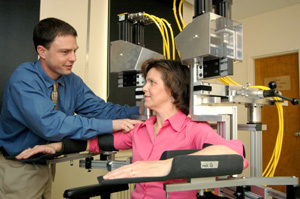
© Science Daily
A researcher from
Queen's University has created
a medical tool that will improve the way brain injury and disease are assessed in patients.
Stephen Scott, creator of the medical tool and a professor at the Centre for Neuroscience Studies at Queen's University, developed the tool to assess brain function. This type of objective tool could eventually be used to design better therapies for treating brain disease or injury.
The medical tool is called the
KINARM Assessment Station, and it is the only objective tool capable of assessing brain function. KINARM consists of a chair with robotic arms and a virtual reality system which guides the patients through several tasks. These standardized tasks mimic everyday activities such as hitting a ball with a virtual paddle. After completing these tasks, KINARM creates a detailed evaluation that specifies any abnormal behavior.
"The beauty of this system is that it captures the subtle deficits caused by a brain injury that are not measured by traditional tests," said Scott. "Traditional testing methods, such as touching a finger to the nose or bouncing a ball, just don't capture the complexity of brain processes."
Other researchers from around the globe are using virtual reality systems to stray away from traditional testing methods as well. For instance,
a study funded by the
National Institutes of Health has shown that video games are capable of revealing how the brain responds to its surroundings. Brain activity patterns were recorded in rats walking through a virtual reality environment using single nerve cell resolution, which is 100 times more accurate and precise than current imaging techniques. Researchers discovered that the speed in which a rat moves within the virtual environment determines how they perceive that specific setting. Also, they found that consistent exercise within a virtual environment helps stroke patients regain arm and hand function to a certain extent.
"Our brains continuously change as we experience the world," said Veronique Bohbot, Ph.D, of the
Douglas Mental Health University Institute and
McGill University. "New technologies and research methods now allow researchers to study that change, investigating individual differences in the way people use spatial memory, navigation and motor function, as well as implications for the use of navigation devices such as GPS. Many potential real-life therapies inspired by video games are already emerging from the virtual world."
Through the use of virtual reality systems like KINARM, health care workers will be able to assess the full effects brain injury and disease have on the body's ability to function. With this information, better therapy and treatment could be made available for those who suffer from stroke, cerebral palsy, fetal alcohol syndrome, Parkinson's, MS or an accident. This sort of research could also help those in the military or involved in professional sports, which are two occupations that deal with head injuries often.
"This system has the potential to do for the diagnosis of brain injury what X-rays did for diagnosing muscular and skeletal injuries," said John Molloy, President and CEO of Queen's University
PARTEQ Innovations.
The KINARM Assessment Station will be presented at
The Society for Neuroscience Conference in San Diego on November 15.
tested on the psychos running the planet too ?